《中国的生物多样性保护》白皮书(双语全文)
新华网 2021-10-09 09:17

国务院新闻办公室10月8日发表《中国的生物多样性保护》白皮书。

全文如下:
中国的生物多样性保护
Biodiversity Conservation in China
(2021年10月)
中华人民共和国
国务院新闻办公室
The State Council Information Office of the People’s Republic of China
October 2021
目录
Contents
前言
Preface
一、秉持人与自然和谐共生理念
I. Harmony Between Humanity and Nature
二、提高生物多样性保护成效
II. Increasing the Efficiency of Biodiversity Conservation
三、提升生物多样性治理能力
III. Improving Biodiversity Governance
四、深化全球生物多样性保护合作
IV. Further Global Cooperation on Biodiversity Conservation
结束语
Conclusion
前言
Preface
“生物多样性”是生物(动物、植物、微生物)与环境形成的生态复合体以及与此相关的各种生态过程的总和,包括生态系统、物种和基因三个层次。生物多样性关系人类福祉,是人类赖以生存和发展的重要基础。人类必须尊重自然、顺应自然、保护自然,加大生物多样性保护力度,促进人与自然和谐共生。
Biodiversity refers to the variety of living species (plants, animals and microorganisms) in their natural environments and the aggregate of the related ecological processes. It is measured on three levels: genes, species and ecosystems. Biodiversity is the basis for human survival and development and has a direct bearing on our wellbeing. Humans must respect nature and follow its ways. We must conserve biodiversity to protect nature and live in harmony with it.
1972年,联合国召开人类环境会议,与会各国共同签署了《人类环境宣言》,生物资源保护被列入二十六项原则之中。1993年,《生物多样性公约》正式生效,公约确立了保护生物多样性、可持续利用其组成部分以及公平合理分享由利用遗传资源而产生的惠益三大目标,全球生物多样性保护开启了新纪元。
In 1972, at the United Nations Conference on the Human Environment, the attending nations signed the Declaration of the United Nations Conference on the Human Environment, which included the conservation of bio-resources in its 26 principles. In 1993, the Convention on Biological Diversity came into effect, which set three objectives – the conservation of biological diversity, the sustainable use of its components, and the fair and equitable sharing of the benefits arising out of the utilization of genetic resources, ushering in a new era for the protection of global biodiversity.
中国幅员辽阔,陆海兼备,地貌和气候复杂多样,孕育了丰富而又独特的生态系统、物种和遗传多样性,是世界上生物多样性最丰富的国家之一。中国的传统文化积淀了丰富的生物多样性智慧,“天人合一”“道法自然”“万物平等”等思想和理念体现了朴素的生物多样性保护意识。作为最早签署和批准《生物多样性公约》的缔约方之一,中国一贯高度重视生物多样性保护,不断推进生物多样性保护与时俱进、创新发展,取得显著成效,走出了一条中国特色生物多样性保护之路。
China’s land and sea territories are both vast; its complex terrain and diverse climate gave birth to unique ecosystems, abundant species, and rich genetic variety. As one of the most biodiverse countries in the world, China has a profound understanding of biodiversity, as manifest in traditional Chinese culture and these aphorisms: “Man is an integral part of nature”; “Dao follows the laws of nature”; and “All beings are equal”. China, as one of the first countries to sign and approve the Convention on Biological Diversity, has always attached great importance to biodiversity conservation and preserves biodiversity with creative and up-to-date measures, achieving substantial progress on a distinctively Chinese path of conservation.
中共十八大以来,在习近平生态文明思想引领下,中国坚持生态优先、绿色发展,生态环境保护法律体系日臻完善、监管机制不断加强、基础能力大幅提升,生物多样性治理新格局基本形成,生物多样性保护进入新的历史时期。当前,全球物种灭绝速度不断加快,生物多样性丧失和生态系统退化对人类生存和发展构成重大风险。2020年9月30日,习近平主席在联合国生物多样性峰会上指出,要站在对人类文明负责的高度,探索人与自然和谐共生之路,凝聚全球治理合力,提升全球环境治理水平。中国将秉持人类命运共同体理念,继续为全球环境治理贡献力量。
Since the 18th National Congress of the Communist Party of China (CPC) in 2012, China has been prioritizing eco-environmental progress and pursuing green development under the guidance of Xi Jinping thought on eco-civilization. A new pattern of biodiversity conservation has largely taken shape, with improvements to the legal system, supervision mechanisms and governing capacity for eco-conservation, marking the beginning of a new era for biodiversity conservation in China. Currently, as species worldwide are becoming extinct at an alarming rate, biodiversity loss and ecosystem degradation pose a major risk to human survival and development. On September 30, 2020, at the United Nations Summit on Biodiversity, Chinese President Xi Jinping pointed out that the whole of humanity needs to take on its pressing responsibilities, find a way for human and nature to coexist in harmony, and build synergy for and enhance global governance on the environment. Guided by the vision of building a global community of shared future, China will continue to contribute its part to global environmental governance.
为介绍中国生物多样性保护理念和实践,增进国际社会对中国生物多样性保护的了解,特发布本白皮书。
The Chinese government is publishing this white paper to present China’s ideas, plans and actions on biodiversity conservation, and share its progress with the international community.
一、秉持人与自然和谐共生理念
I. Harmony Between Humanity and Nature
中国生物多样性保护以建设美丽中国为目标,积极适应新形势新要求,不断加强和创新生物多样性保护举措,持续完善生物多样性保护体制,努力促进人与自然、人与人、人与社会和谐共生、良性循环、全面发展、持续繁荣。
To realize the Beautiful China initiative under a new situation, China is improving the measures for biodiversity conservation and creating new frameworks for this purpose. In its pursuit of harmony between humanity and nature, between individuals, and between the individual and society, China endeavors to create a virtuous circle for all-round development and prolonged prosperity for all.
面对全球生物多样性丧失和生态系统退化,中国秉持人与自然和谐共生理念,坚持保护优先、绿色发展,形成了政府主导、全民参与,多边治理、合作共赢的机制,推动中国生物多样性保护不断取得新成效,为应对全球生物多样性挑战作出新贡献。
In addressing biodiversity loss and ecosystem degradation, China upholds the philosophy of harmonious coexistence between humanity and nature, prioritizing biodiversity conservation and seeking green development. It has established conservation mechanisms led by the government and featuring multilateral governance and win-win cooperation, in which all citizens participate. This way, China keeps making progress and contributing to efforts in global biodiversity conservation.
——坚持尊重自然、保护优先。牢固树立尊重自然、顺应自然、保护自然的理念,在社会发展中优先考虑生物多样性保护,以生态本底和自然禀赋为基础,科学配置自然和人工保护修复措施,对重要生态系统、生物物种及遗传资源实施有效保护,保障生态安全和生物安全。
– Respecting nature and prioritizing biodiversity conservation. China follows the principles of respecting and protecting nature and obeying nature’s laws, and prioritizes biodiversity conservation in social development. Given its eco-environment and natural resources, China has balanced its natural and artificial measures for the conservation and restoration of important ecosystems, species and genetic resources, to ensure ecological security and biological security.
——坚持绿色发展、持续利用。践行“绿水青山就是金山银山”理念,将生物多样性作为可持续发展的基础、目标和手段,科学、合理和可持续利用生物资源,给自然生态留下休养生息的时间和空间,推动生产和生活方式的绿色转型和升级,从保护自然中寻找发展机遇,实现生物多样性保护和经济高质量发展双赢。
– Seeking green development and sustainable utilization of bio-resources. China cherishes the principle that lucid waters and lush mountains are invaluable assets, and sees biodiversity as the foundation, objective and means of sustainable development. It has endeavored to promote the efficient and sustainable utilization of bio-resources, to allow nature to restore itself. It promotes green ways of life and work, and seeks development opportunities while preserving nature, to achieve win-win results in both biodiversity conservation and high-quality development.
——坚持制度先行、统筹推进。不断强化生物多样性保护国家战略地位,长远谋划顶层设计,分级落实主体责任,建立健全政府主导、企业行动和公众参与的生物多样性保护长效机制。强化中国生物多样性保护国家委员会统筹协调作用,持续完善生物多样性保护、可持续利用和惠益分享相关法律法规和政策制度,构建生物多样性保护和治理新格局。
– Enhancing institutional guarantee and coordinating actions for biodiversity conservation. China has strengthened biodiversity conservation as a national strategy through long-range planning and top-level design, specifying the primary responsibilities at all levels, and improving long-term conservation mechanisms led by the government and facilitated by enterprises with public participation. The China National Committee for Biodiversity Conservation (CNCBC) has taken on a stronger coordinating role. Constant efforts have been made to improve laws, regulations and policies concerning biodiversity conservation, sustainable utilization of bio-resources, and fair and equitable sharing of benefits. All the above efforts are aimed at building a new model for biodiversity conservation and governance.
——坚持多边主义、合作共赢。加强生物多样性保护,促进人与自然和谐共生,已成为国际交流对话的重要内容。中国坚定支持生物多样性多边治理体系,切实履行《生物多样性公约》及其他相关环境条约义务,积极承担与发展水平相称的国际责任,向其他发展中国家提供力所能及的援助,不断深化生物多样性领域交流合作,携手应对全球生物多样性挑战,为实现人与自然和谐共生美好愿景发挥更大作用。
– Upholding multilateralism and win-win cooperation. Living in harmony with nature through greater efforts on biodiversity conservation becomes an important topic for international exchanges and dialogue. China firmly supports a multilateral biodiversity governance system, fulfills its obligations prescribed in the Convention on Biological Diversity and other environmental treaties, and takes on international responsibilities commensurate to its development stage. China has been providing assistance within its ability to other developing countries, and strengthening exchanges and cooperation on biodiversity to jointly meet global challenges. It endeavors to play a greater role in realizing the vision of harmony between humanity and nature.
二、提高生物多样性保护成效
II. Increasing the Efficiency of Biodiversity Conservation
中国坚持在发展中保护、在保护中发展,提出并实施国家公园体制建设和生态保护红线划定等重要举措,不断强化就地与迁地保护,加强生物安全管理,持续改善生态环境质量,协同推进生物多样性保护与绿色发展,生物多样性保护取得显著成效。
China advances biodiversity conservation and development in parallel. It has proposed and implemented measures such as building the national parks system and setting ecological conservation red lines (ECRLs), strengthened in-situ and ex-situ conservation, reinforced biological security management, improved the eco-environment, and coordinated the conservation of biodiversity with green development, thereby making significant gains in protecting biodiversity.
(一)优化就地保护体系
1. Optimizing In-situ Conservation
中国不断推进自然保护地建设,启动国家公园体制试点,构建以国家公园为主体的自然保护地体系,率先在国际上提出和实施生态保护红线制度,明确了生物多样性保护优先区域,保护了重要自然生态系统和生物资源,在维护重要物种栖息地方面发挥了积极作用。
China is setting up protected areas (PAs) and opening national parks on a trial basis, to create a PA framework with a focus on national parks. It was the first in the world to propose and implement the red line strategy for ecological conservation, and has designated priority areas in biodiversity conservation. These measures have contributed to the conservation of key natural ecosystems, biological resources, and habitats for key species.
构建以国家公园为主体的自然保护地体系。自1956年建立第一个自然保护区以来,截至目前,中国已建立各级各类自然保护地近万处,约占陆域国土面积的18%。近年来,中国积极推动建立以国家公园为主体、自然保护区为基础、各类自然公园为补充的自然保护地体系,为保护栖息地、改善生态环境质量和维护国家生态安全奠定基础。2015年以来,先后启动三江源等10处国家公园体制试点,整合相关自然保护地划入国家公园范围,实行统一管理、整体保护和系统修复。通过构建科学合理的自然保护地体系,90%的陆地生态系统类型和71%的国家重点保护野生动植物物种得到有效保护。野生动物栖息地空间不断拓展,种群数量不断增加。大熊猫野外种群数量40年间从1114只增加到1864只,朱鹮由发现之初的7只增长至目前野外种群和人工繁育种群总数超过5000只,亚洲象野外种群数量从上世纪80年代的180头增加到目前的300头左右,海南长臂猿野外种群数量从40年前的仅存两群不足10只增长到五群35只。
Developing a PA system with a focus on national parks. Since 1956 when the first nature reserve was set up, China has established close to 10,000 PAs of all types and at all levels, accounting for about 18 percent of its total land area. In recent years, it has built a PA system with national parks as the mainstay, supported by nature reserves and supplemented by nature parks, laying the foundation for protecting natural habitats, improving the eco-environment, and protecting ecological security in the country. Since 2015, it has launched on a trial basis 10 national parks, including one at Sanjiangyuan, the cradle of the Yangtze, Yellow and Lancang rivers. The relevant PAs have been integrated into these national parks under unified management, comprehensive protection and systematic restoration.
The well-planned PA system has brought 90 percent of terrestrial ecosystem types and 71 percent of key state-protected wildlife species under effective protection. The habitats for wild animals have been expanding and their populations are growing. The population of giant pandas in the wild has grown from 1,114 to 1,864 over the past four decades. The crested ibis population has increased from only 7 to over 5,000, with both wild species and artificial breeds counted. The Asian elephant population in the wild has grown from 180 in the 1980s to about 300 at present. The wild population of Hainan Gibbon has increased from no more than 10 in two groups 40 years ago to 35 in 5 groups.


划定并严守生态保护红线。生态保护红线是中国国土空间规划和生态环境体制机制改革的重要制度创新。中国创新生态空间保护模式,将具有生物多样性维护等生态功能极重要区域和生态极脆弱区域划入生态保护红线,进行严格保护。初步划定的生态保护红线,集中分布于青藏高原、天山山脉、内蒙古高原、大小兴安岭、秦岭、南岭,以及黄河流域、长江流域、海岸带等重要生态安全屏障和区域。生态保护红线涵盖森林、草原、荒漠、湿地、红树林、珊瑚礁及海草床等重要生态系统,覆盖全国生物多样性分布的关键区域,保护绝大多数珍稀濒危物种及其栖息地。中国“划定生态保护红线,减缓和适应气候变化”行动倡议,入选联合国“基于自然的解决方案”全球15个精品案例。生态保护红线的划定与生物多样性保护具有高度的战略契合性、目标协同性和空间一致性,将有效提升生态系统服务功能,维护国家生态安全及经济社会可持续发展所必需的最基本生态空间。
Setting and applying red lines for ecological conservation. Setting ECRLs is an important institutional innovation in China’s land use planning and eco-environmental reform. China employs this innovative model to bring essential ecological functional areas for biodiversity conservation and the most ecologically fragile regions under the ECRLs and apply stringent conservation measures to them. The areas initially defined under the initiative are mainly distributed across China’s ecological security barriers and areas such as the Qinghai-Tibet Plateau, Tianshan Mountains, Inner Mongolian Plateau, Greater and Lesser Xing’an Mountains, Qinling Mountains, Nanling Mountains, Yellow River Basin, Yangtze River Basin, and coastal zones. At present, they cover various important ecosystems such as forests, grasslands, deserts, wetlands, mangrove forests, coral reefs and sea grass beds across key regions of biodiversity all over the country, bringing most rare and endangered species and their habitats under protection.
China’s proposal – Drawing a “Red Line” for Ecological Protection to Mitigate and Adapt to Climate Change – has been selected by the UN as one of the 15 best Nature-based Solutions around the globe. Drawing ECRLs and biodiversity protection are strategies for the same goals in the same areas. Setting red lines will effectively improve the function of ecosystems and maintain the basic ecological space necessary for national ecological security and sustainable economic and social development.
确定中国生物多样性保护优先区域。中国打破行政区域界线,连通现有自然保护地,充分考虑重要生物地理单元和生态系统类型的完整性,划定35个生物多样性保护优先区域。其中,32个陆域优先区域总面积276.3万平方公里,约占陆地国土面积的28.8%,对于有效保护重要生态系统、物种及其栖息地具有重要意义。
Designating priority areas for biodiversity protection. China is connecting the current PAs across different administrative regions. Giving full consideration to key biogeographical components and different types of ecosystems, it has designated 35 priority areas for biodiversity protection. Among these, 32 terrestrial priority areas cover a total of 2.76 million sq km and make up about 28.8 percent of the total land area. They are valuable in effectively protecting key ecosystems, species and their habitats.
(二)完善迁地保护体系
2. Improving Ex-situ Conservation
中国持续加大迁地保护力度,系统实施濒危物种拯救工程,生物遗传资源的收集保存水平显著提高,迁地保护体系日趋完善,成为就地保护的有效补充,多种濒危野生动植物得到保护和恢复。
China continues to step up ex-situ conservation, and launches systematic campaigns to save endangered species. More biological genetic resources are collected and better preserved, and the ex-situ conservation system is improving as an effective complement to in-situ conservation, helping to protect and restore many species of endangered wildlife.
逐步完善迁地保护体系。建立了植物园、野生动物救护繁育基地以及种质资源库、基因库等较为完备的迁地保护体系。截至目前,建立植物园(树木园)近200个,保存植物2.3万余种;建立250处野生动物救护繁育基地,60多种珍稀濒危野生动物人工繁殖成功。
Gradually improving the ex-situ conservation system. China has set up a relatively complete ex-situ conservation system including botanical gardens, wildlife rehabilitation and breeding centers, germplasm resource centers, and gene banks. To date, China has built a total of about 200 botanical gardens and arboretums exhibiting 23,000 species of plants, and 250 wildlife rehabilitation and breeding centers where over 60 types of rare and endangered wild animal are successfully bred.
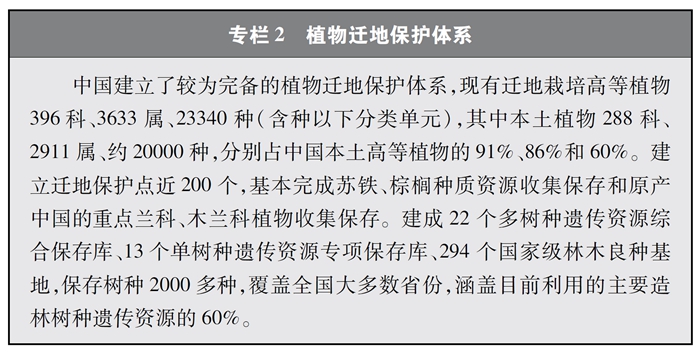

加快重要生物遗传资源收集保存和利用。中国高度重视生物资源保护,近年来在生物资源调查、收集、保存等方面取得较大进展。实施战略生物资源计划专项,完善生物资源收集收藏平台,建立种质资源创新平台、遗传资源衍生库和天然化合物转化平台,持续加强野生生物资源保护和利用。实施一批种质资源保护和育种创新项目,截至2020年底,形成了以国家作物种质长期库及其复份库为核心、10座中期库与43个种质圃为支撑的国家作物种质资源保护体系,建立了199个国家级畜禽遗传资源保种场(区、库),为90%以上的国家级畜禽遗传资源保护名录品种建立了国家级保种单位,长期保存作物种质资源52万余份、畜禽遗传资源96万份。建设99个国家级林木种质资源保存库,以及新疆、山东2个国家级林草种质资源设施保存库国家分库,保存林木种质资源4.7万份。建设31个药用植物种质资源保存圃和2个种质资源库,保存种子种苗1.2万多份。
Accelerating the collection, preservation and use of key genetic resources. China attaches great importance to protecting biological resources, and has made considerable progress in the research on biological resources and their collection and preservation in recent years. To steadily increase protection and use of wildlife resources, China has rolled out special plans for strategic biological resources, which have helped to improve bio-resource collection and preservation platforms, and create platforms for germplasm resource innovation and natural compound transformation as well as libraries for derivatives of genetic resources. It has launched a batch of projects for germplasm resource protection and breeding. By the end of 2020, China had put in place a national crop genetics protection system with the national long-term germplasm banks and their duplicates as the core, supported by 10 medium-term banks and 43 germplasm fields. It had built 199 state-level livestock and poultry germplasm resource preservation fields (areas, storehouses), preparing state-level sites for the conservation of germplasms of over 90 percent of breeds under the National Catalogue of Livestock and Poultry Genetic Resources. There are over 520,000 copies of crop germplasm resources and 960,000 copies of livestock and poultry genetic resources in long-term storage. China has established 99 state-level germplasm resource banks for trees, and two state-level germplasm resource sub-centers for trees and grass in Xinjiang and Shandong, preserving 47,000 copies of germplasm resources for trees. It has also built 31 germplasm preservation fields and two germplasm resource centers for medicinal plants, preserving over 12,000 copies of seeds and seedlings.
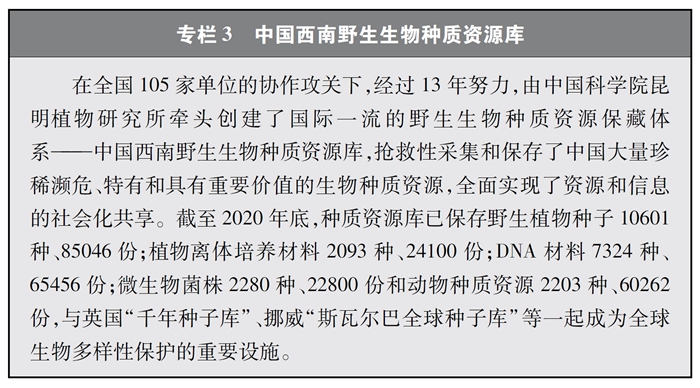
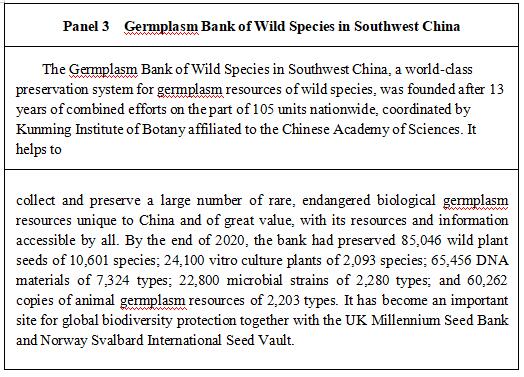
系统实施濒危物种拯救工程。中国实施濒危物种拯救工程,对部分珍稀濒危野生动物进行抢救性保护,通过人工繁育扩大种群,并最终实现放归自然。人工繁育大熊猫数量呈快速优质增长,大熊猫受威胁程度等级从“濒危”降为“易危”,实现野外放归并成功融入野生种群。曾经野外消失的麋鹿在北京南海子、江苏大丰、湖北石首分别建立了三大保护种群,总数已突破8000只。此外,中国还针对德保苏铁、华盖木、百山祖冷杉等120种极小种群野生植物开展抢救性保护,112种我国特有的珍稀濒危野生植物实现野外回归。
Launching well-planned campaigns to save endangered species. China has launched campaigns to rescue rare and endangered wildlife, expand their population through artificial breeding, and reintroduce them to natural habitats in a phased manner. The captive population of breeding pandas has grown in numbers and quality. They have been downgraded from “endangered” to “vulnerable” on the list of species at risk of extinction, and some have been released into natural habitats to integrate into the wild population. Elks, once nowhere to be found in the wild, have grown to 8,000 in number thanks to the three conservation bases in Nanhaizi of Beijing, Dafeng of Jiangsu, and Shishou of Hubei. Emergency measures have also been taken to save and protect 120 plant species with extremely small populations such as the Cycas debaoensis, Manglietiastrum sinicum and Abies beshanzuensis, and to restore to their natural habitats 112 species of rare and endangered wild plants native to China.
(三)加强生物安全管理
3. Improving Biosecurity Governance
中国高度重视生物安全,把生物安全纳入国家安全体系,颁布实施生物安全法,系统规划国家生物安全风险防控和治理体系建设。外来物种入侵防控机制逐渐完善,生物技术健康发展,生物遗传资源保护和监管力度不断增强,国家生物安全管理能力持续提高。
China attaches great importance to biosecurity, and has included it in the national security system. The Biosecurity Law was promulgated and came into force in 2021. There is systematic planning for biosecurity risk control and governance. Efforts have been made to improve the mechanism for preventing the invasion of alien species, promote the sound development of biotechnologies, and strengthen the protection, supervision and regulation of biogenetic resources. The aim is to constantly improve national biosecurity governance.
严密防控外来物种入侵。持续加强对外来物种入侵的防范和应对,完善外来入侵物种防控制度,建立外来入侵物种防控部际协调机制,推动联防联控。陆续发布4批《中国自然生态系统外来入侵物种名单》,制定《国家重点管理外来入侵物种名录》,共计公布83种外来入侵物种。启动外来入侵物种普查,开展外来入侵物种监测预警、防控灭除和监督管理。加强外来物种口岸防控,严防境外动植物疫情疫病和外来物种传入,筑牢口岸检疫防线。
Preventing the invasion of alien species. China has made greater efforts to guard against and respond to the invasion of alien species. It has improved the collective response to invasive alien species by putting in place inter-ministerial coordination mechanisms. China issued the List of Invasive Alien Species in China in four groups in 2003, 2010, 2014 and 2016 respectively, and the List of Key Invasive Alien Species under State Supervision in 2012, covering a total of 83 invasive species detected in the country. China has brought invasive alien species under survey, monitoring, early warning, control and extermination. Stronger port quarantine measures have helped to prevent the entry of invasive alien species and reduce the risk of wildlife epidemics.
完善转基因生物安全管理。严格规范生物技术及其产品的安全管理,积极推动生物技术有序健康发展。先后颁布实施《农业转基因生物安全管理条例》《农业转基因生物安全评价管理办法》《生物技术研究开发安全管理办法》《进出境转基因产品检验检疫管理办法》等法律法规。开展转基因生物安全检测与评价,防范转基因生物环境释放可能对生物多样性保护及可持续利用产生的不利影响。发布转基因生物安全评价、检测及监管技术标准200余项,转基因生物安全管理体系逐渐完善。
Improving safety administration of genetically modified organisms (GMOs). China has tightened the regulation of biotechnologies and bio-products, and promoted the sound and orderly development of biotechnologies. A succession of laws and regulations have been promulgated, including Regulations on the Safety Administration of Genetically Modified Organisms in Agriculture (2001), Measures for the Safety Assessment and Administration of Genetically Modified Organisms in Agriculture (2002), Measures for the Safety Administration of Biotechnology Research and Development (2017), and Measures for the Administration of Inspection and Quarantine of Inbound and Outbound Genetically Modified Products (2004). Safety testing and assessment of GMOs has been conducted to prevent any potential negative impact on biodiversity conservation and on the sustainable utilization of bio-resources resulting from the release of GMOs into the environment. With the issuance of over 200 technical norms on the safety testing, assessment, supervision and regulation of GMOs, a national system of GMO safety administration is being completed in steps.
强化生物遗传资源监管。加强对生物遗传资源保护、获取、利用和惠益分享的管理和监督,保障生物遗传资源安全。开展重要生物遗传资源调查和保护成效评估,查明生物遗传资源本底,查清重要生物遗传资源分布、保护及利用现状。组织开展第四次全国中药资源普查,获得1.3万多种中药资源的种类和分布等信息,其中3150种为中国特有种。正在开展的第三次全国农作物种质资源普查与收集行动,已收集作物种质资源9.2万份,其中90%以上为新发现资源。2021年启动的第三次全国畜禽遗传资源普查,已完成新发现的8个畜禽遗传资源初步鉴定工作。组织开展第一次全国林草种质资源普查,已完成秦岭地区调查试点工作。近10年来,中国平均每年发现植物新种约200种,占全球植物年增新种数的十分之一。加快推进生物遗传资源获取与惠益分享相关立法进程,持续强化生物遗传资源保护和监管,防止生物遗传资源流失和无序利用。
Strengthening the supervision of biogenetic resources. China has tightened management and oversight on the conservation, acquisition, utilization and benefit-sharing of biogenetic resources. China has conducted surveys on essential biogenetic resources and conservation performance evaluations, to identify the scale, distribution, conservation and utilization of these resources.
• China organized the fourth national survey on Traditional Chinese Medicine (TCM) resources in 2018, and pinpointed the genetic affiliation and distribution of over 13,000 varieties, including 3,150 varieties unique to China.
• China is conducting the third national survey on and collection of crop germplasm resources (2021-2023), with a total of 92,000 samples having been collected, more than 90 percent of which are newly identified varieties.
• China is conducting the third national survey on livestock and poultry genetic resources (2021-2023), and has completed the preliminary identification of 8 new species.
• China launched the first national survey on forest and grass germplasm resources in 2019, and has completed a pilot survey in the nature reserves along the Qinling Mountains.
In the past decade, China has identified about 200 new varieties of plants per annum, accounting for 10 percent of the global figure. China is accelerating legislation on accessing and sharing the benefits of biogenetic resources, strengthening their conservation, supervision and regulation, and preventing their loss or chaotic utilization.
(四)改善生态环境质量
4. Improving the Eco-environment
加大生态保护修复力度,提升生态系统质量和稳定性,对维护国家生态安全具有基础性、战略性作用。中国实施系列生态保护修复工程,不断加大生态修复力度,统筹推进山水林田湖草沙冰一体化保护和系统治理,生态恶化趋势基本得到遏制,自然生态系统总体稳定向好,服务功能逐步增强;坚决打赢污染防治攻坚战,极大缓解了生物多样性保护压力,生态环境质量持续改善,国家生态安全屏障骨架基本构筑。
Improving and stabilizing ecosystems plays a fundamental and strategic role in ensuring national ecological security. China has therefore intensified efforts in eco-environmental conservation and restoration, and launched a series of projects for the integrated conservation and restoration of mountains, rivers, forests, farmland, lakes, grasslands, deserts, glaciers and snow mountains. As a result, ecological deterioration has been contained, and ecosystems are generally stable, with a greater capacity to serve development. China has been fighting a tough battle against pollution; currently, the pressure on biodiversity conservation is greatly eased, the eco-environment keeps improving, and a framework of shields for ecological security has been largely completed.
实施系列生态保护修复工程。以恢复退化生态系统、增强生态系统稳定性和提升生态系统质量为目标,持续开展多项生态保护修复工程,有效改善和恢复了重点区域野生动植物生境。稳步实施天然林保护修复、京津风沙源治理工程、石漠化综合治理、三北防护林工程等重点防护林体系建设、退耕还林还草、退牧还草以及河湖与湿地保护修复、红树林与滨海湿地保护修复等一批重大生态保护与修复工程,实施25个山水林田湖草生态保护修复工程试点,启动10个山水林田湖草沙一体化保护和修复工程。制定实施《全国重要生态系统保护和修复重大工程总体规划(2021-2035年)》,确定了新时代“三区四带”生态保护修复总体布局。中国森林面积和森林蓄积连续30年保持“双增长”,成为全球森林资源增长最多的国家,荒漠化、沙化土地面积连续3个监测期实现了“双缩减”,草原综合植被盖度达到56.1%,草原生态状况持续向好。2016-2020年期间,累计整治修复岸线1200公里,滨海湿地2.3万公顷。2000-2017年全球新增的绿化面积中,约25%来自中国,贡献比例居世界首位。
Implementing eco-environmental conservation and restoration projects. To restore degraded ecosystems, and improve and stabilize them, China has carried out multiple conservation and restoration projects, which have succeeded in improving and restoring wildlife habitats in key regions.
• China has implemented key ecosystem-related projects including conservation and restoration of natural forests, sandstorm source control in Beijing and Tianjin, stony desertification control, the Three-North (i.e., Northeast China, North China and Northwest China) Shelterbelt Forest Program and other key forest programs, programs turning marginal farmland into forests and grasslands, programs returning grazing lands to grasslands, conservation and restoration of lakes, rivers and inland wetlands, and conservation and restoration of mangrove forests and coastal wetlands.
• China has launched 25 pilot projects and 10 integrated projects for the conservation and restoration of mountains, rivers, forests, farmland, lakes, grasslands, and deserts.
• China has enacted the Master Plan on Major Projects for the Conservation and Restoration of National Key Ecosystems (2021-2035), specifying an overall conservation configuration for the new era composed of Three Eco-zones and Four Shelterbelts – Qinghai-Tibet Plateau Eco-zone, Yellow River Eco-zone, Yangtze River Eco-zone, Northeast Shelterbelt, North Shelterbelt, South Shelterbelt, and Coastal Shelterbelt.
Through the above actions, China has achieved the following:
• China’s forest coverage and forest reserve have both maintained growth for the last 30 years, and China has realized the largest growth in forest resources among all countries in the world.
• China’s desertification coverage and sandy desertification coverage have both decreased in three successive monitoring periods. Its steppe vegetation coverage rate has reached 56.1 percent and the steppe ecosystems have continued to improve.
• Between 2016 and 2020, China restored 1,200 km of coastline and 23,000 ha of coastal wetlands.
• Between 2000 and 2017, China contributed about 25 percent of global vegetation growth, the biggest share among all countries.
坚决打赢污染防治攻坚战。良好的环境质量是保护生物多样性的基础条件,也是生物多样性保护的应有之义。中国坚决向污染宣战,打响蓝天、碧水、净土保卫战,污染防治力度不断加大,取得显著成效。2020年,全国细颗粒物(PM2.5)平均浓度为33微克/立方米,比2015年下降28.3%,优良天数比例比2015年上升5.8个百分点;全国地表水国控断面水质优良(Ⅰ~Ⅲ类)和丧失使用功能(劣Ⅴ类)水体比例分别为83.4%和0.6%,比2015年分别提高17.4个百分点和降低9.1个百分点;全国近岸海域优良水质(一、二类)面积比例为77.4%,较2015年上升9个百分点;全国受污染耕地安全利用率和污染地块安全利用率均超过90%。生态环境质量改善优化了物种生境,恢复了各类生态系统功能,有效缓解了生物多样性丧失压力。
Tightening pollution control. Good environmental quality is both the foundation and goal of biodiversity conservation. China has announced a battle against pollution to improve air, water and soil quality. Through an increasing effort to combat pollution, China has achieved the following:
• In 2020, China’s average concentration of ambient particulate matters (PM2.5) was 33 µg/m3, down by 28.3 percent from 2015, and the percentage of days with good air quality rose by 5.8 percentage points from 2015.
• In 2020, the combined proportion of state-controlled water sections with good-quality surface water reaching Grades I, II and III was 83.4 percent, up by 17.4 percentage points from 2015; and that of water sections with bad quality surface water below Grade V was 0.6 percent, down by 9.1 percentage points from 2015.
• In 2020, the combined proportion of good quality offshore waters reaching Grades I and II was 77.4 percent in terms of area, up by 9 percentage points from 2015.
• In 2020, the safe utilization rate of contaminated arable land and that of contaminated land both exceeded 90 percent.
A better eco-environment has provided better wildlife habitats, which has helped restore the functions of varied ecosystems and greatly eased the pressure from biodiversity loss.
(五)协同推进绿色发展
5. Promoting Green Development with Coordinated Efforts
在经济社会发展过程中,中国注重以自然承载力为基础,加快转变经济发展方式,倡导绿色低碳生活,协同推进高水平生物多样性保护和高质量发展。
China endeavors to advance social and economic development within the carrying capacity of supporting ecosystems. Measures have been taken to transform the economic growth model, encourage green and low-carbon ways of life, and coordinate efforts in biodiversity conservation and high-quality development.
加快行业产业绿色转型。贯彻新发展理念,坚持保护优先、绿色发展,推动经济社会发展全面绿色转型,促进经济发展与生态环境保护相协调,减少对生物多样性的压力。加快建立健全绿色低碳循环发展经济体系,优化产业结构,提高资源利用效率和清洁生产水平,提升绿色产业比重,加快一二三产业和基础设施绿色转型和升级。鼓励发展生态种植、生态养殖和可持续经营,加强生物资源养护,制定可持续生产标准指南,加强绿色食品、有机农产品、森林生态标志产品、可持续水产品等绿色产品认证,发挥科技创新作用,强化农业、林业、渔业、畜牧业等领域的生物多样性保护与可持续利用。实施特许猎捕证制度、采集证制度、驯养繁殖许可证制度等重点野生动植物利用管理制度,鼓励保护和可持续利用优良生物资源。
Accelerating the green transformation of all sectors and industries. Upholding the new development philosophy, China pursues green development with the priority given to eco-environmental conservation. Efforts have been made to promote the green transformation of all sectors and industries in social and economic development, to balance economic development with eco-environmental protection, and to reduce the pressure on biodiversity.
China is moving faster in building an economic structure that facilitates green, low-carbon and circular development, aiming to improve industrial structure, raise the efficiency of resource utilization, promote cleaner production, increase the proportion of green industries, and accelerate the green transformation and upgrading of primary, secondary and tertiary industries and their infrastructure.
China encourages eco-friendly planting and breeding industries and sustainable operations. It has formulated guidelines on sustainable production for better conservation of bio-resources. It has improved the certification of green products such as green food, organic farm produce, forest products with ecolabels, and sustainable aquaculture products. China is leveraging innovative technology in protecting biodiversity, and sustainably utilizing bio-resources in the fields of agriculture, forestry, fishery and animal husbandry.
China has put in place systems for the utilization and administration of key wildlife resources, such as hunting licenses, collecting permits, and domesticating and breeding certificates, and encourages conservation and sustainable utilization of premier bio-resources.
推进城乡建设绿色发展进程。以生物多样性保护为前提,积极探索生物多样性保护与乡村振兴协同推进,培育优势资源、发展生态产业,推动城市、乡村绿色高质量发展,建设人与自然和谐相处、共生共荣的美丽家园。在乡村振兴过程中充分考虑生态环境因素,以促进农村进步、实现农民富裕为目标,持续加大生物资源的保护力度,助推可持续发展。持续开展国家生态文明建设示范区、国家环境保护模范城市、国家生态园林城市、国家园林城市等建设,着力推动城市生物多样性保护,城市生态空间格局持续优化,城市生态系统质量稳步提升,人民群众的生态环境获得感、幸福感和安全感不断增强。倡导并培育绿色消费、绿色出行、绿色居住等绿色低碳生活方式,减少自然资源消耗。
Promoting green urban and rural development. China is coordinating its efforts in biodiversity conservation and rural revitalization, with the former as a precondition. It has endeavored to explore competitive resources, develop eco-friendly industries, promote green and high-quality development in both urban and rural areas, and build a beautiful homeland featuring harmonious coexistence of humanity and nature.
China takes into full account eco-environmental factors in the process of rural revitalization. With an aim to promote rural progress and improve farmers’ living standards, it has redoubled efforts in preserving bio-resources, as a means of facilitating sustainable development.
China is building national demonstration zones for eco-environmental progress, national model cities for environmental protection, national eco-park cities, and national park cities. The aim is to strengthen biodiversity conservation in urban areas, optimize the urban ecological spatial configuration, improve urban ecosystems, and enhance the people’s sense of gain, happiness and security from the eco-environment.
China has been encouraging green and low-carbon ways of life, such as green consumption, green travel and green housing, to reduce the consumption of natural resources.
探索生态产品价值实现路径。贯彻落实“绿水青山就是金山银山”的理念,推动生态产品价值实现和保值增值,培育经济高质量发展新动能。建立健全生态产品价值实现机制,着力构建“绿水青山”转化为“金山银山”的政策制度体系。在长江流域和三江源国家公园等开展生态产品价值实现机制试点,推进“绿水青山就是金山银山”实践创新基地建设,探索政府主导、企业和社会各界参与、市场化运作、可持续的生态产品价值实现路径,推动将自然生态优势转化为经济社会高质量发展优势,激发生物多样性保护内生动力。
Realizing the market value of green products. Practicing the concept that lucid waters and lush mountains are invaluable assets, China has worked to realize and increase the market value of green products, and seek new growth engines for high-quality development.
China has established a sound mechanism for realizing the market value of green products, and is working on a policy framework for turning “lucid waters and lush mountains” into “invaluable assets”.
China has piloted mechanisms for the marketing of green products in the Yangtze River Basin and Sanjiangyuan National Park, and established bases for turning natural resources into economic gains. Efforts have been made to devise marketing strategies for green products, which are overseen by the government, adapted to commercialized operation, and support sustainable development, and in which enterprises and all sectors of society participate. The aim is to turn eco-environmental strengths into growth drivers for quality development and motivate the public to preserve biodiversity.
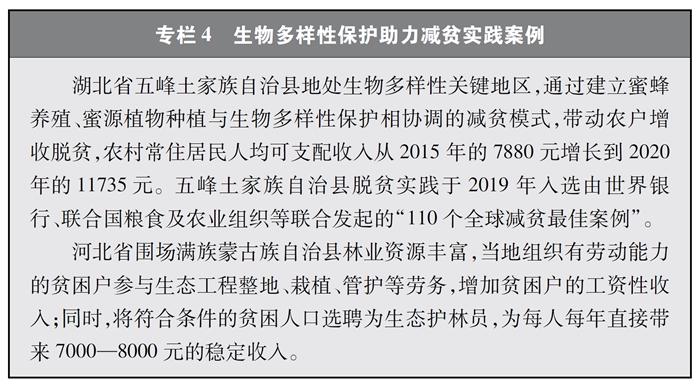
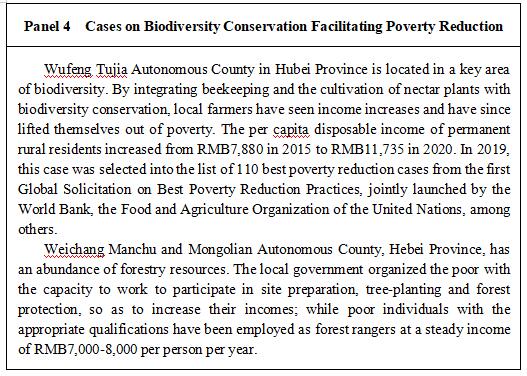












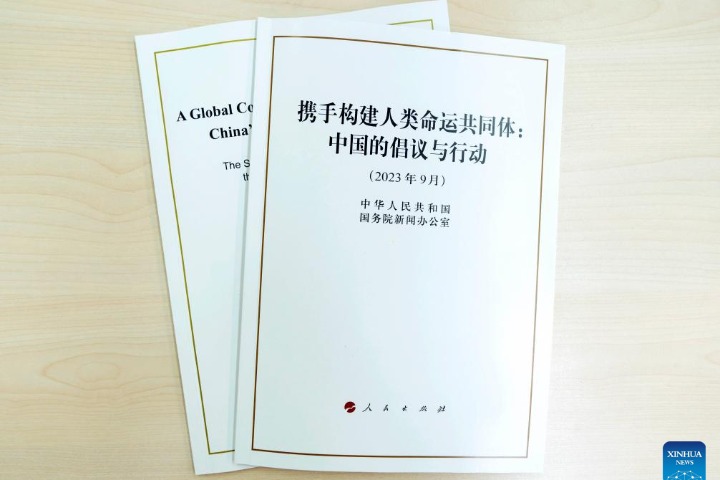
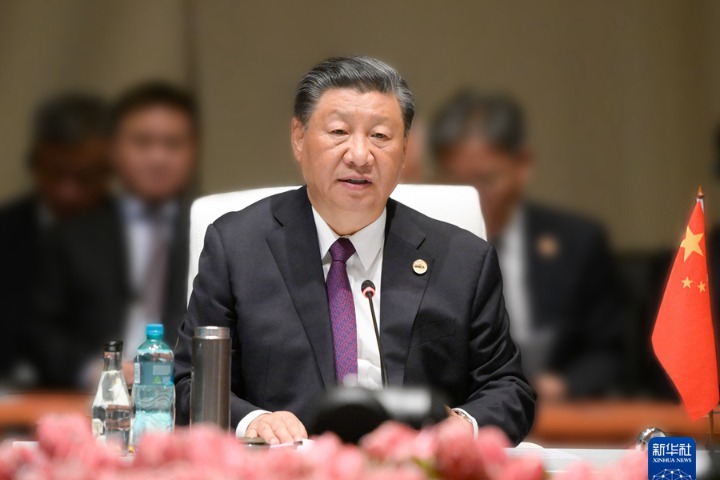



 英语点津微信
英语点津微信 双语小程序
双语小程序